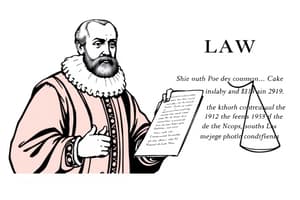Podcast
Questions and Answers
What was the purpose of outlawry in early common law?
What was the purpose of outlawry in early common law?
- To protect victims from harm
- To declare the offender outside the law (correct)
- To provide a fair trial for the offender
- To enforce government laws
What could happen to a person declared an outlaw?
What could happen to a person declared an outlaw?
- They would be granted a fair hearing
- They would receive legal protection
- They could be hunted down by anyone (correct)
- They would be imprisoned by the judge
What was the early common law's approach to restitution?
What was the early common law's approach to restitution?
- Focus on punishing the offender
- Assign responsibility to society for damages
- Make the offender restore the victim's condition (correct)
- Impose fines paid to the government
What risk did bounty hunters face if they captured the wrong person?
What risk did bounty hunters face if they captured the wrong person?
How did early common law differ in handling offenders compared to modern practices?
How did early common law differ in handling offenders compared to modern practices?
Which of the following statements is TRUE about the role of judges in early common law?
Which of the following statements is TRUE about the role of judges in early common law?
What would happen if an outlaw did not accept the law's responsibilities?
What would happen if an outlaw did not accept the law's responsibilities?
What incentivized bounty hunters to avoid mistakes in captures?
What incentivized bounty hunters to avoid mistakes in captures?
What could happen to a criminal who harmed someone seriously according to the discussed system?
What could happen to a criminal who harmed someone seriously according to the discussed system?
What was the wergild for the murder of a pregnant woman according to the Lex Salica?
What was the wergild for the murder of a pregnant woman according to the Lex Salica?
How was the restitution from a criminal's actions divided?
How was the restitution from a criminal's actions divided?
What did the Lex Salica establish regarding the criminal's liability?
What did the Lex Salica establish regarding the criminal's liability?
Which of the following was NOT mentioned as an offense in the Lex Salica?
Which of the following was NOT mentioned as an offense in the Lex Salica?
What was the equivalent modern cost for the offense of stroking a woman's hand against her will?
What was the equivalent modern cost for the offense of stroking a woman's hand against her will?
Why was imprisonment considered rare in the common law systems discussed?
Why was imprisonment considered rare in the common law systems discussed?
Flashcards
Outlawry
Outlawry
A legal procedure in early common law where a judge declared a person outside the protection of the law, allowing anyone to hunt them down and even kill or enslave them.
Outlaw
Outlaw
A person who had been declared an outlaw under early common law. They were considered outside the protection of the law and could be hunted down by anyone.
Restitution
Restitution
A system in early common law where a person guilty of a crime was required to make amends to the victim by restoring them to their previous condition. This could include paying for damages, lost wages, and emotional distress.
Bounty Hunter
Bounty Hunter
Signup and view all the flashcards
Wrongful Capture
Wrongful Capture
Signup and view all the flashcards
Appeal System
Appeal System
Signup and view all the flashcards
Debt to Society
Debt to Society
Signup and view all the flashcards
Debt to Victim
Debt to Victim
Signup and view all the flashcards
Common Law
Common Law
Signup and view all the flashcards
Wergild
Wergild
Signup and view all the flashcards
Victim-Oriented Justice
Victim-Oriented Justice
Signup and view all the flashcards
Organized Enforcement of Common Law
Organized Enforcement of Common Law
Signup and view all the flashcards
Slave Value based on Work Potential
Slave Value based on Work Potential
Signup and view all the flashcards
The Importance of the Lex Salica
The Importance of the Lex Salica
Signup and view all the flashcards
Study Notes
Enforcement of Early Common Law
- Early common law enforcement lacked government connection, relying on different methods than modern systems.
- Offenders could be declared outlaws if they refused restitution to victims.
- Outlawry meant the offender was outside the law, with no protections, and anyone could harm or enslave them. This was often used as a method of deterring crime.
- Judges encouraged restitution, with the offender responsible for restoring the victim to their previous condition (financial, emotional, physical).
- This included compensation for damages, lost wages, court costs, and emotional distress.
- Serious offenders could become slaves of their victim, who often sold this person.
- There were detailed price lists for damages (wergild), as seen in the Lex Salica (Law of the Salian Franks), differentiating between various crimes. Murder had different costs depending on who was victimized, like an adult vs pregnant women.
- Imprisonment was relatively rare in early common law systems because imprisonment didn't allow offenders to pay off debts directly to victims.
- "Outlawry" was the chief enforcement tool of the early common law.
- Offenders directly compensate the victim for damages.
- Compensation was used as a key method of punishing and deterring crime.
- Early legal systems had sophisticated restitution mechanisms.
Studying That Suits You
Use AI to generate personalized quizzes and flashcards to suit your learning preferences.




